Quiet Chicken? Is there such a bird? This may sound outlandish, but having chickens and happy neighbors is possible.
If you live in an urban area, keeping chickens can be tricky. Many cities have laws and regulations regarding noise levels and the number of animals that can be kept on one property.

There’s always a good chance there are one or two neighbors who may not be pleased if you start keeping backyard chickens.
But what if you could choose a chicken known for its quietness? That would make it much easier to fit into the neighborhood without ruffling feathers.
Here’s a look at which quiet chicken breeds make great urban neighbors and ways to keep them from getting bored and noisy.
Is it possible to have quiet chickens?
Yes, it is possible to have a quiet chicken. Some chicken breeds are quieter than others, and while they still chit-chat and make noise at the egg-laying time, they are much lower in volume and less likely to be flustered. There are no completely quiet chicken breeds.
Bored chickens can also make a fuss, so keeping them with plenty of space and a variety of things to occupy their days will go a long way to keeping quiet chickens quiet.
Why Does A Quiet Chicken Get Noisy?
- Egg Laying Time ( read why chickens stop laying eggs here)
- Too Little Outdoor or Indoor Space
- Threat of Predator
- Changes like moving the coop or a new barking dog in the neighborhood.
- Boredom
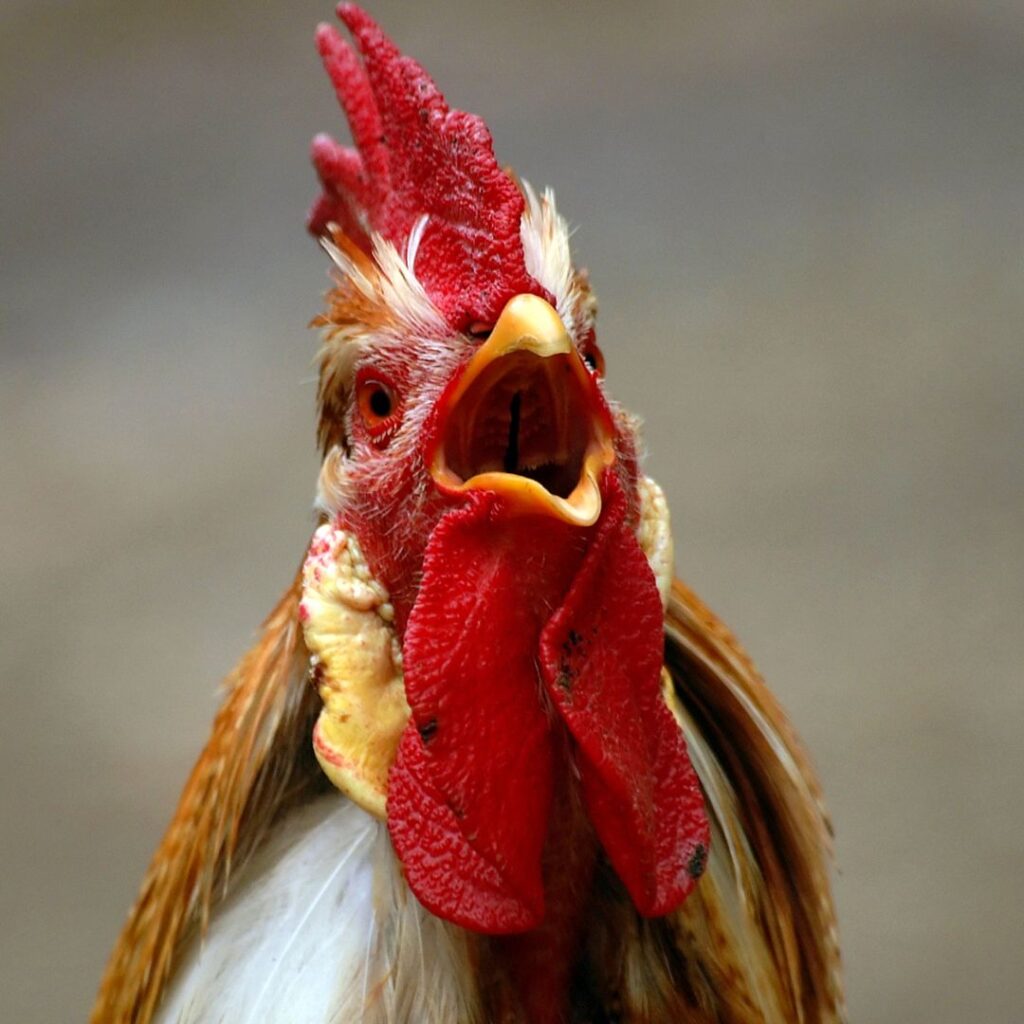
Are there non-crowing roosters?
Rooster crowing is part of life, and it’s a protective function to alert their flock of danger. There are quiet roosters like the Cochins and Buff Orpingtons. They still crow and are not as loud or frequent as other breeds.
If you are a homesteader hoping to sustain your flock, these roosters (baby daddy) won’t cause too much trouble in a neighborhood, and the hens (baby mamma) are quite broody, making them great moms. Read more about the best and worst breeds of broody hens here.
Note: keep in mind most rural areas forbid roosters. If you are hoping to hatch eggs, you can order fertilized eggs and hatch them yourself using an incubator.
11+ Quiet Chicken Breeds That Do Well For Urban And Suburban Chicken Keepers (With Pictures)
Ameraucana
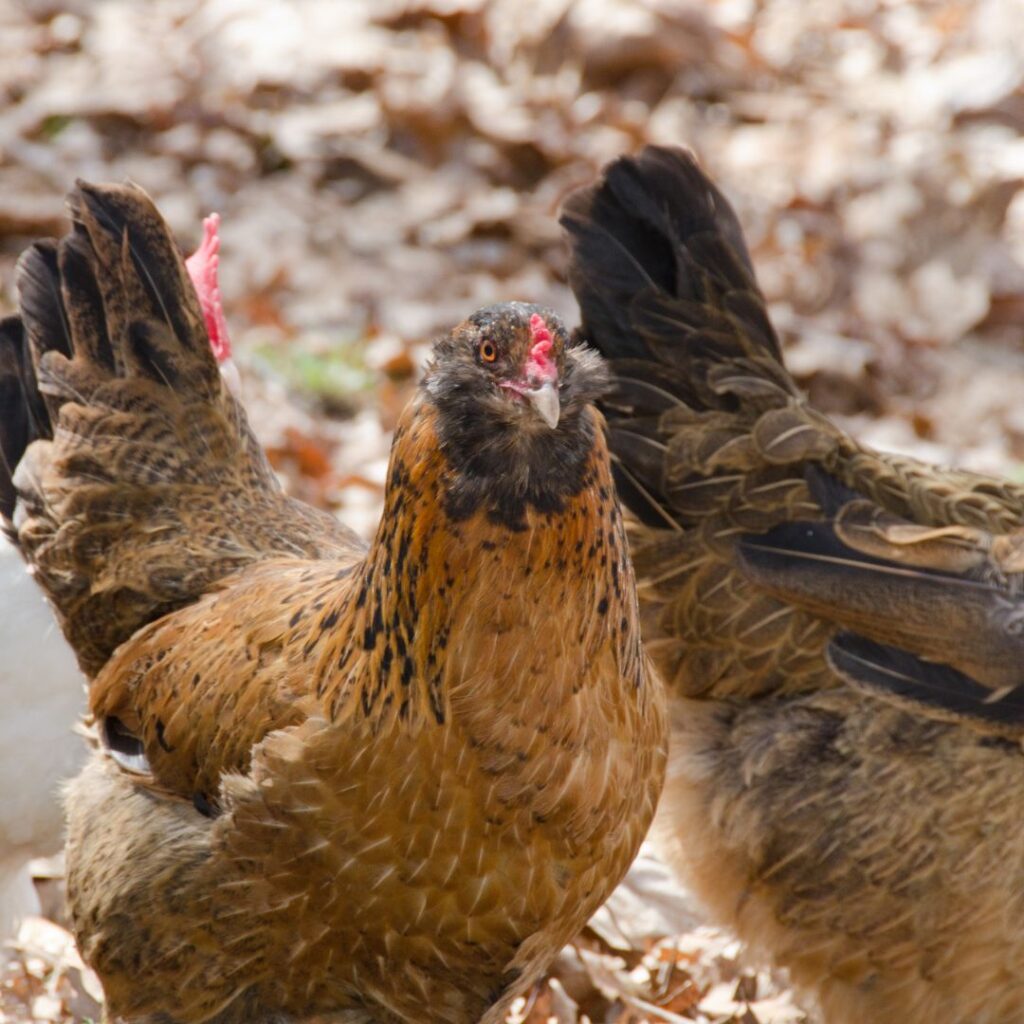
Ameraucana chickens are a great choice for colder areas due to their cold hardiness: their pea comb and small wattles help them to avoid frostbite. They come in various colors and are typically gentler birds that get along well with other chicken breeds.
These birds are known for being gentle and non-confrontational towards other chickens, even though they can be timid around sudden noises or movements.
With their heartwarming personalities and ability to withstand harsh winters, Ameraucana chickens make an excellent choice for all chicken lovers.
- Eggs: Large Blue eggs (sometimes bluish green) 180 – 200 per year
- Foraging: Yes
- Heat Tolerant: Yes
- Cold Tolerant: Yes
- Meat Production: Yes
- Age til Mature: 22 weeks
- Ameraucana Roosters Weigh: 7 pounds
- Ameraucana Hens Weigh: 4 pounds
Australorp
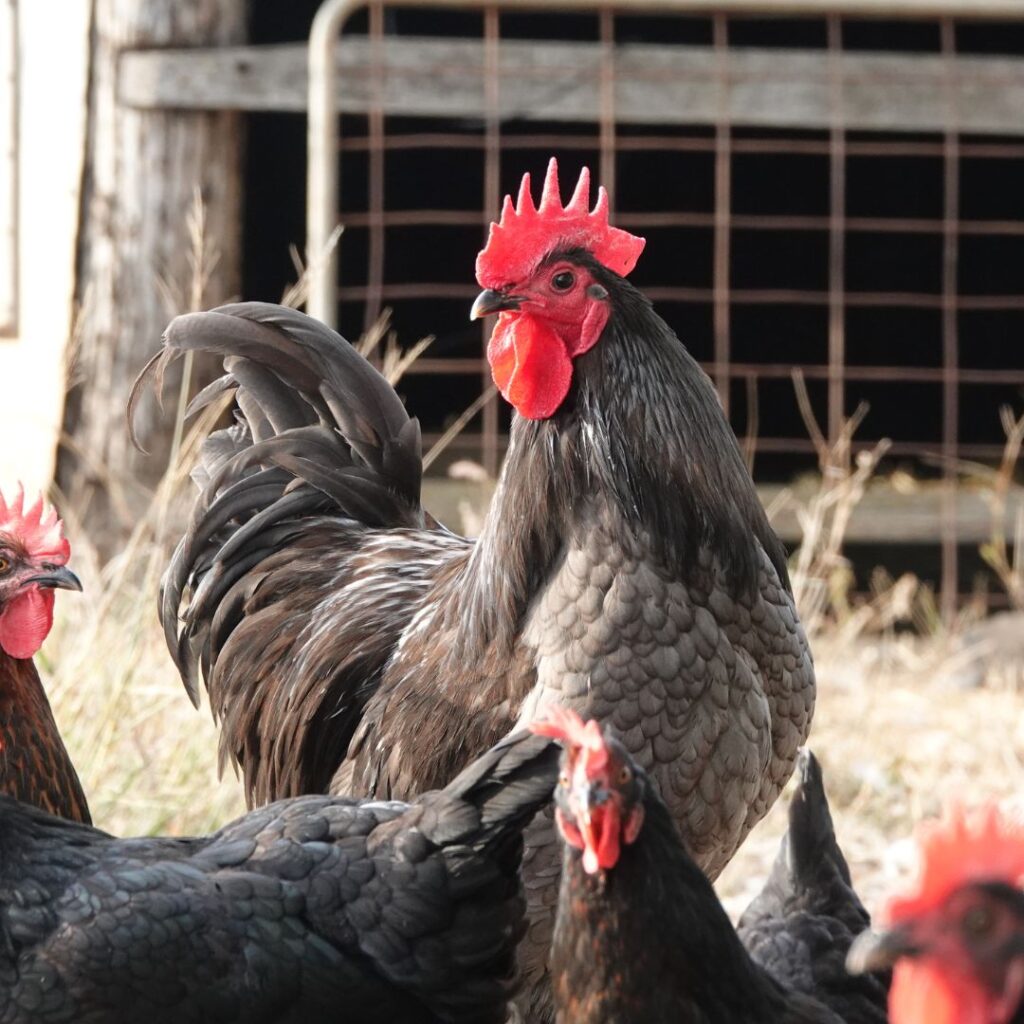
The Australorp is an excellent option for cold winter climates and urban or suburban areas. It has a heavy body type (Australorp hens weigh 5.5 lbs) with beautiful black iridescent feathers, a small single comb, and small wattles.
These chickens are not just a pleasure to look at but well-adapted for confinement.
Despite their larger size, these chickens are surprisingly quiet breeds and gentle when in confined spaces – but allow them to stretch their wings in a good-sized outdoor run area, and they’ll be contented and healthy.
- Eggs: Large Brown Eggs, 200 – 280 per year
- Foraging: Yes
- Heat Tolerant: Yes
- Cold Tolerant: Yes
- Meat Production: Yes
- Age til Mature: 20 weeks
- Rooster Weight: 8 pounds
- Hen Weight: 5 1/2 pounds
Barred Plymouth Rock, aka Plymouth Rock, aka Barred Rock
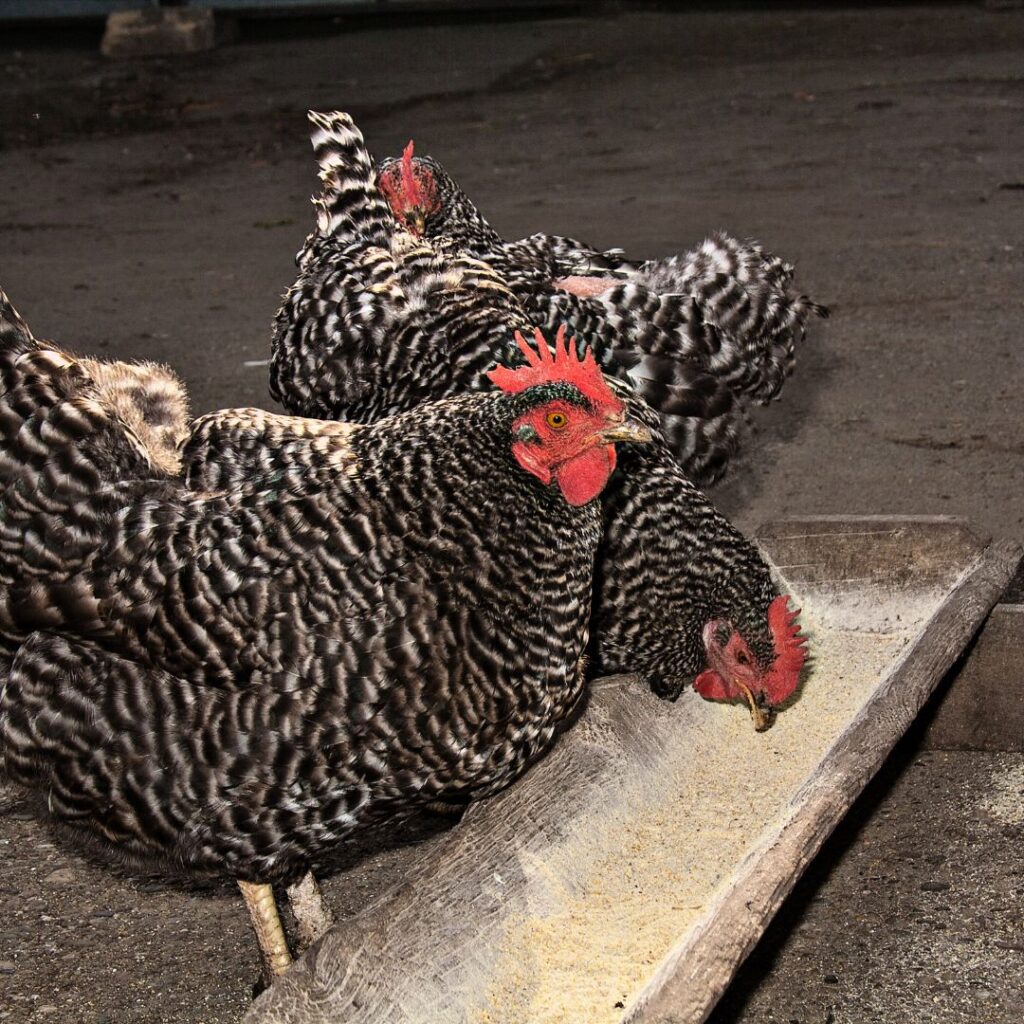
The Plymouth Barred Rock is considered a heritage chicken breed by the American Poultry Association (APA) and the Livestock Conservancy. It is one of the most popular dual-purpose chickens in the United States. It originated and was used to develop other popular breeds like Rhode Island Red, New Hampshire Red, and Silver-Laced Wyandotte.
This intelligent breed is known for its hardiness in cold climates and excellent egg production – making them ideal for backyard chicken keeping. The Barred Rock is also frequently bred for its meaty qualities, making it a favorite dual-purpose chicken for most homesteads.
Barred Rock hens are generally known for their hardiness in colder weather compared to their roosters. The rooster’s large combs and wattles leave them more vulnerable to frostbite, so extra protection and care should be taken in the winter.
Plymouth Barred Rock chickens are known to be an incredibly personable and playful breed, not to mention being low-noise and accepting of handling. This bird has become a popular family-friendly homesteader choice both in rural and suburban backyards.
Note: The Plymouth Rock chicken and the Dominique Chicken (aka Dominica) are the two oldest breeds in the U.S.
- Dual Purpose: Yes
- Eggs: Large, Brown, 280 – 300 per year
- Foraging: Yes
- Heat Tolerant: Yes
- Cold Tolerant: Yes
- Meat Production: Yes
- Age til Mature: 20 weeks
- Rooster Weight: 9.5 pounds
- Hen Weight: 7.5 pounds
Brahma
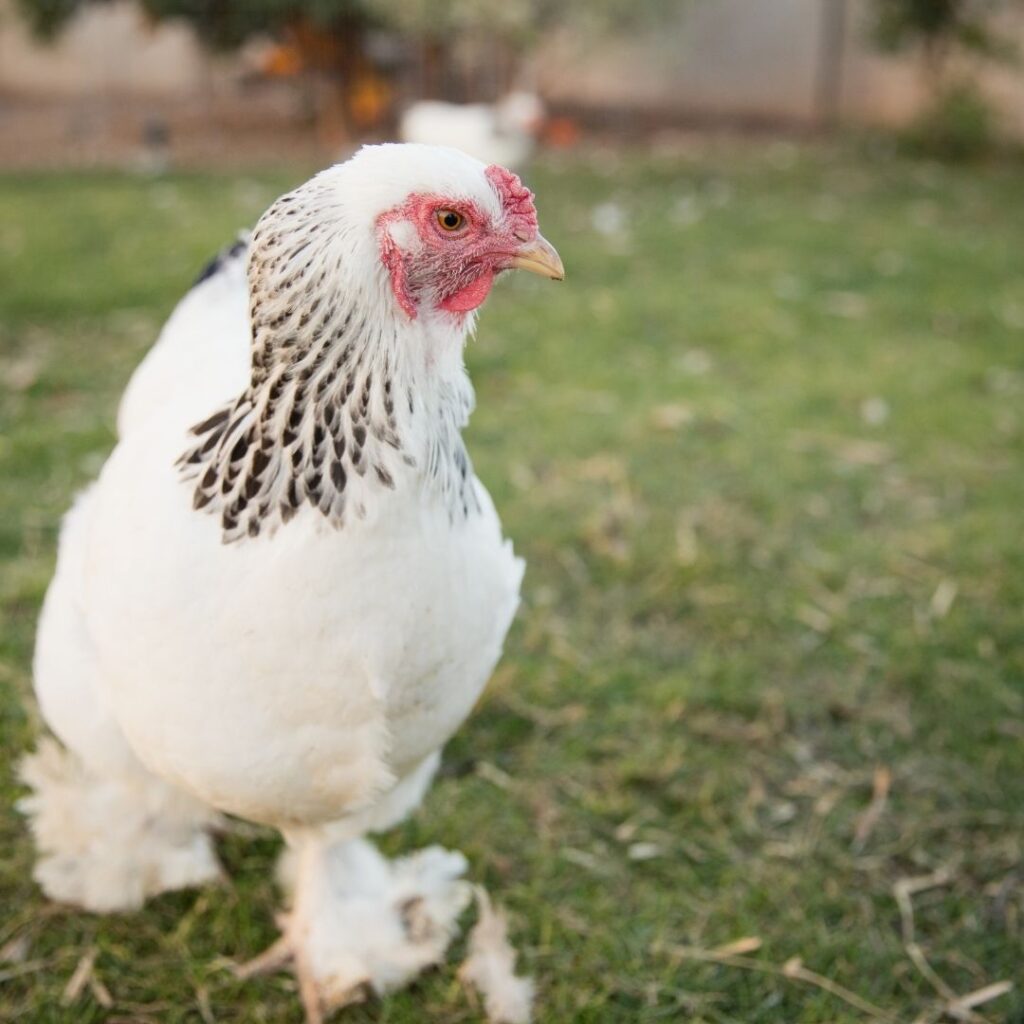
The Brahma Rooster and his hens are popular homestead poultry birds because they make a great dual-purpose breed. Not only are they great egg layers, but they can also be used for meat production.
Their large bodies and feathered legs make these adorably fluffy birds.
Their large size makes them an intimidating sight and keeps hawks away from the roost.
They’re even hardy enough to withstand harsh winter months.
These chickens have a wonderful temperament and are incredibly docile birds, which makes them excellent pets for their human family. Surprisingly for their size, they are a quieter breed making them an obvious choice for city chickens.
- Dual Purpose: Yes
- Eggs: Medium – Large, Brown, 120 -150 eggs per year
- Free-Range: No
- Heat Tolerant: Yes
- Cold Tolerant: Yes
- Meat Production: Yes
- Age til Mature: 20 weeks
- Rooster Weight: 12 pounds
- Hen Weight:9 pounds
Bielefelder
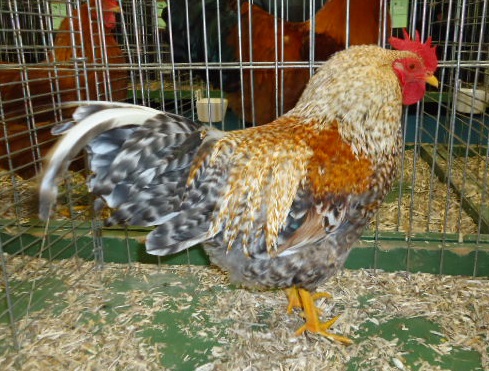
The Bielefelder chicken was developed in the early 1970s by crossing two breeds, the Cuckoo Malines and Welsumers. To further boost its appeal, other established poultry, such as the Plymouth Barred Rocks, Rhode Island Reds, and New Hampshires, were crossbred into the original stock.
These efforts can be seen in the performance of Bielefelders today; they are noted for their efficient egg production with excellent meat quality that is on par with some of the best producers available.
Except for their egg-laying cluck and beautiful presence, you’d hardly know they were there. These chickens are quiet and docile, making an excellent choice for urban and suburban families. They’ve been compared to having a pup, the way they run to greet you.
- Dual Purpose: Yes
- Eggs: Extra Large, Brown eggs- Dark Brown, 230-280 year
- Foraging: Yes
- Heat Tolerant: Yes
- Cold Tolerant: Yes
- Meat Production: Yes
- Age til Mature: 22
- Rooster Weight: 12 pounds
- Hen Weight: 10 pounds
Buff Orpington
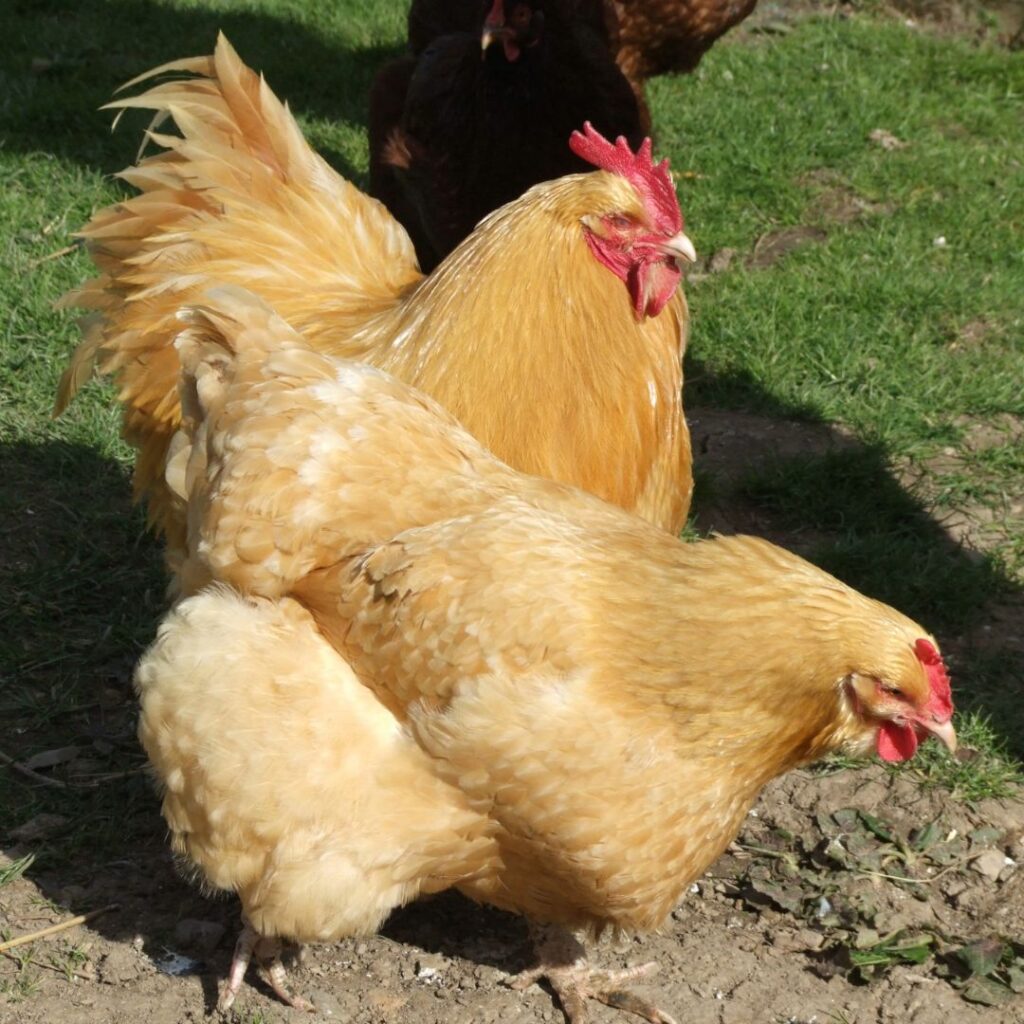
With their thick downy plumage, the Buff Orpington chicken is a beautiful breed of bird that appears on many of the ‘best of’ lists.
They are perfect for colder climates where other chickens may not react as well to the chill. The Buff Orpington thrives in different environments and is known for being docile and gentle, making them popular among families with young children who want to learn about raising a flock.
Not only are they gentle creatures, but they also provide dual-purpose value – farm fresh eggs and meat. Buff Orpingtons are reliable egg layers, only slightly less than other more established breeds such as the Leghorn or Rhode Island Red.
This Buff Orpington is renowned for being a relatively quiet breed compared to other types of poultry – meaning no more neighbors giving you dirty looks or coming over with noise complaints.
- Dual Purpose: Yes
- Eggs: Large Brown, 200 – 280 eggs per year
- Foraging: Yes
- Heat Tolerant: Yes
- Cold Tolerant: Yes
- Meat Production: Yes
- Age til Mature: 20 weeks
- Rooster Weight: 10 pounds
- Hen Weight: 8 pounds
Cochin
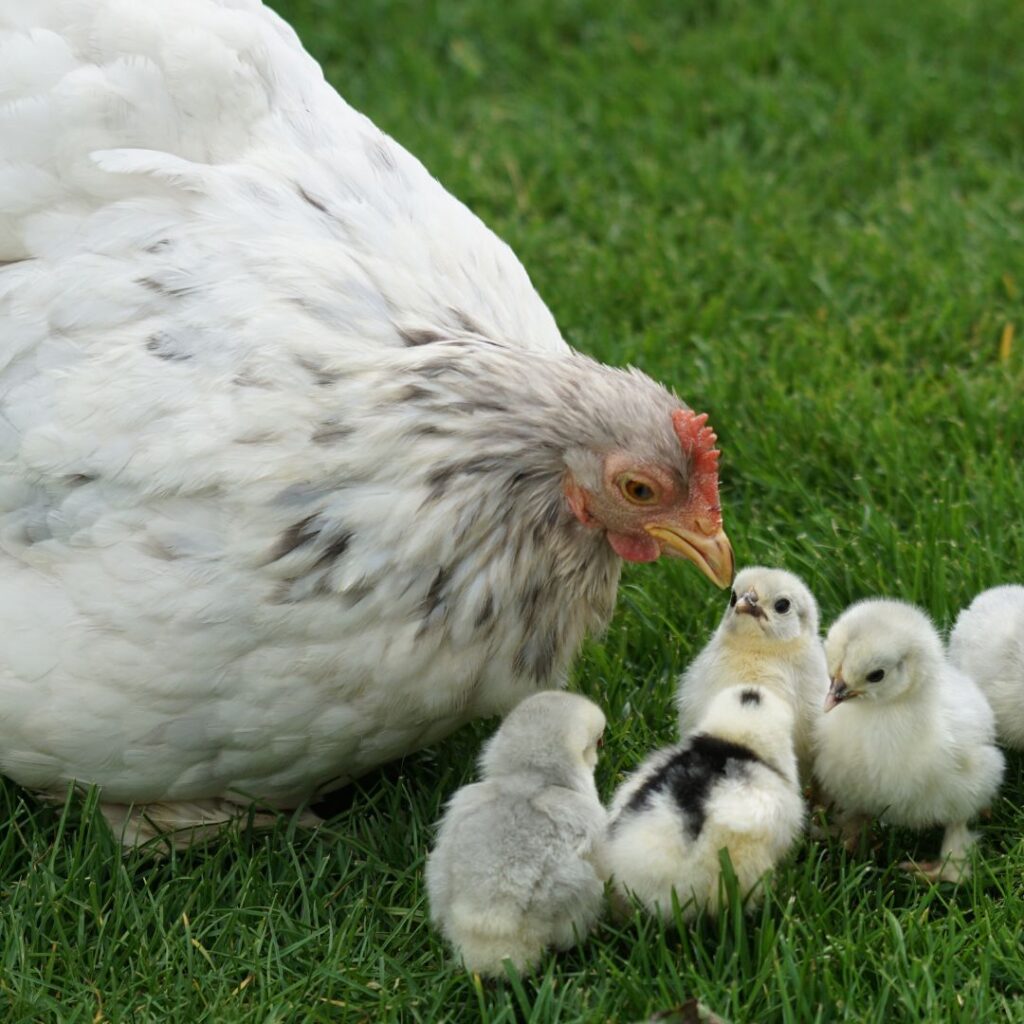
The Cochin chicken is an appealing bird in a backyard flock with their fluffy feathers and endearing heart-shaped appearance. They are larger than other chickens, and their feathers extend down to their feet, giving them a distinctive look.
Cochins are also known for being docile, calm, and non-aggressive birds who will happily stay close to home and not wander too far away. Although they can be shy when it comes to humans, they usually warm up once they get used to their surroundings.
They are best suited to flocks with similarly-natured breeds, such as Orpingtons.
This chicken makes the list as the quietest chicken breeds. While they make a little raucous when laying, they are not chatty or loud.
The Cochin is the ultimate companion bird. These quiet hens are friendly and make great neighbors if you live in a city or suburb.
- Dual Purpose: Yes
- Eggs: Medium, Brown, 120-160 per year
- Foraging: No
- Heat Tolerant: No
- Cold Tolerant: Yes
- Meat Production: Yes
- Age til Mature: 20
- Rooster Weight:11 pounds
- Hen Weight: 8 ½ pounds
Cornish Heritage Breed
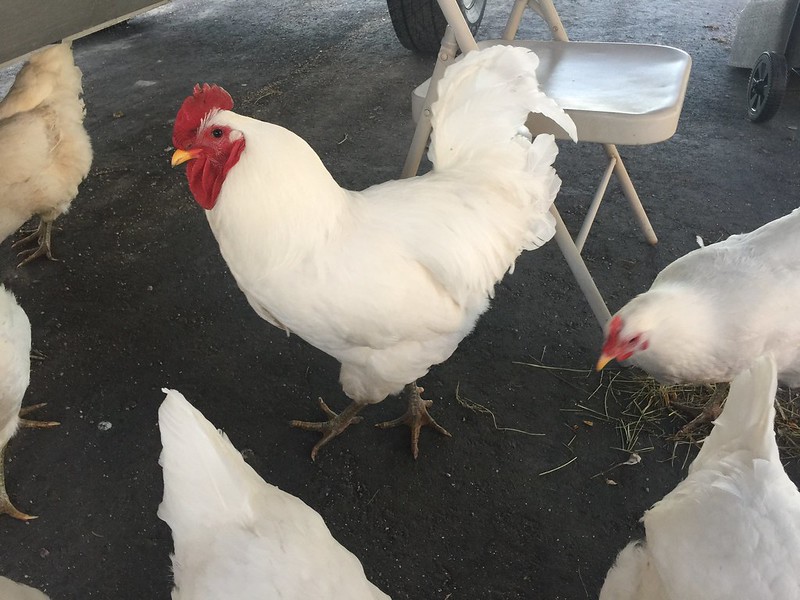
Although it’s increasing rarity, this heritage breed is still widely cherished by avid chicken fans due to its lovely personalities and endearing looks.
While the Cornish doesn’t lay the most eggs, they are great meat birds.
Cornish chickens are a great choice for anyone living in colder climates. Their thicker, weather-resistant feathers keep them better insulated, and their smaller pea combs and wattles help ward off frostbite.
These birds are known for their calm, docile and quiet demeanor.
- Dual Purpose: Yes
- Eggs: Large, Brown, 120-150 eggs per year
- Foraging: Yes
- Heat Tolerant: Yes
- Cold Tolerant: Yes
- Meat Production: Yes
- Age til Mature: 22 weeks
- Rooster Weight: 10 pounds
- Hen Weight: 8 pounds
Easter Eggers
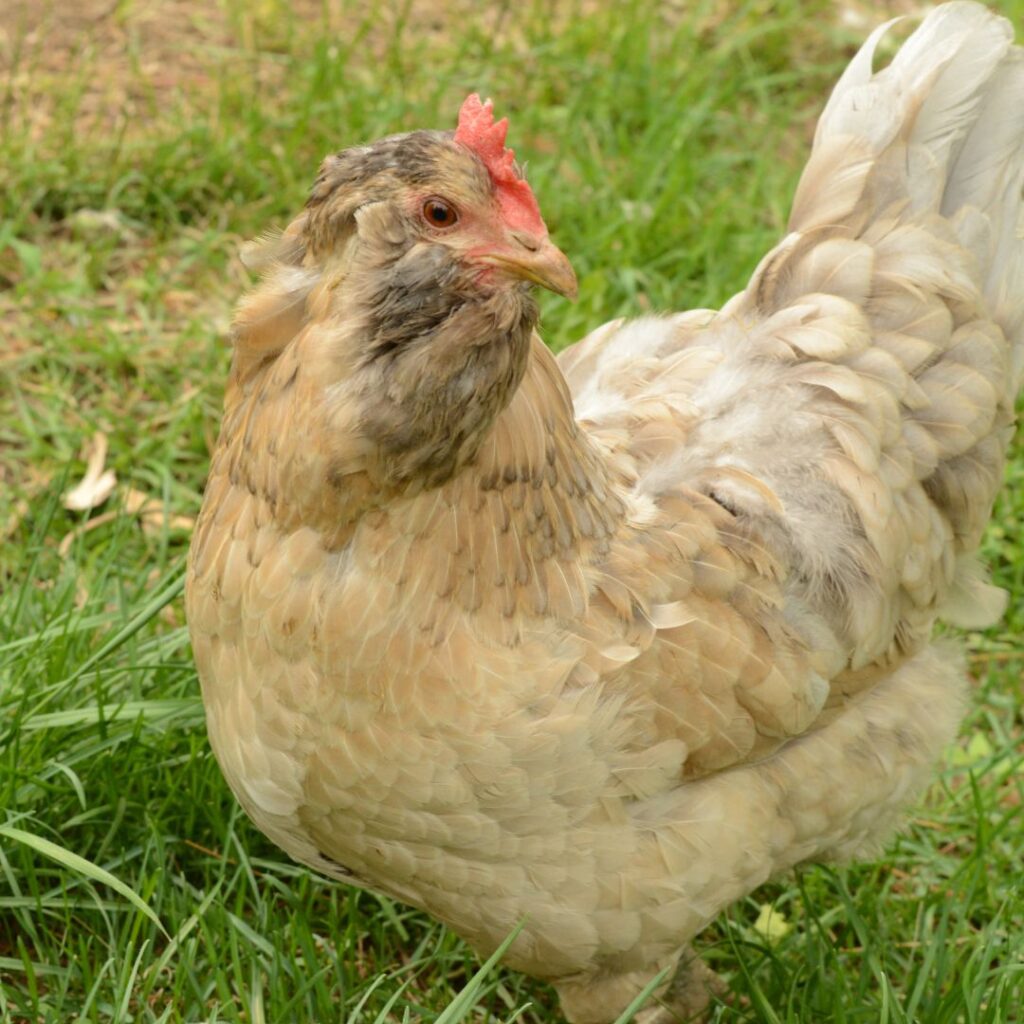
Easter Egger chickens are a popular breed of poultry known for their ability of the Easter Egger Hens to lay colorful eggs in shades of blue, green, pink, and even olive.
The Easter Egger doesn’t have any official standards concerning appearance as they are a mix of many chicken breeds like Araucana or Americana.
Easter Eggers do well in free-ranging and enclosed spaces and a mixed flock.
Easter Egger chickens make a great addition to any family flock thanks to their quiet, gentle nature and curiosity, making them friendly with humans, adults, and especially children alike.
- Dual Purpose: Yes
- Eggs: Medium-large, light blue, light green, and even pink (a small percentage will lay brown), 200-280 eggs per year
- Foraging: Yes
- Heat Tolerant: Yes
- Cold Tolerant: Yes
- Meat Production: Yes
- Age til Mature: 22
- Rooster Weight: 4 pounds
- Hen Weight: 7 pounds
Java Chickens
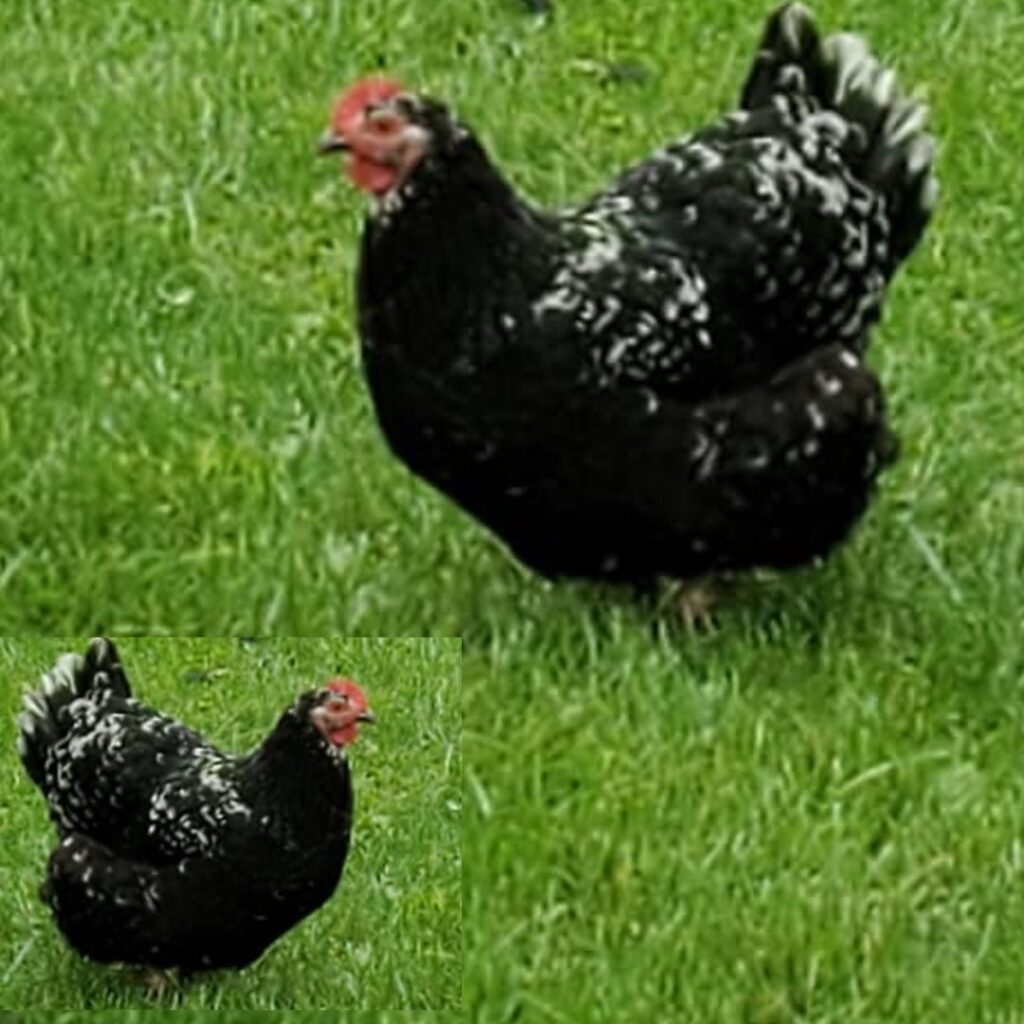
Javas are some of the oldest breeds developed in the United States. Java chickens are an ideal breed for backyard farmers since they are incredibly adaptive and hardy in warm and cold climates. They are great foragers when allowed to roam freely. They are slower to reach maturity, so their meat is moist and flavorful.
These docile birds have a gentle, noble presence and prefer smaller flock environments. They are known to be quiet breeds, making them perfect for anyone looking to add a few feathered friends to the homestead.
- Dual Purpose: Yes
- Eggs: Large, Brown, 15-180 eggs per year
- Foraging: Yes
- Heat Tolerant: Yes
- Cold Tolerant: Yes
- Meat Production: Yes
- Age til Mature: 22 weeks
- Rooster Weight 8- 9 ½ pounds
- Hen Weight: 6 ½ – 8 pounds
Marans
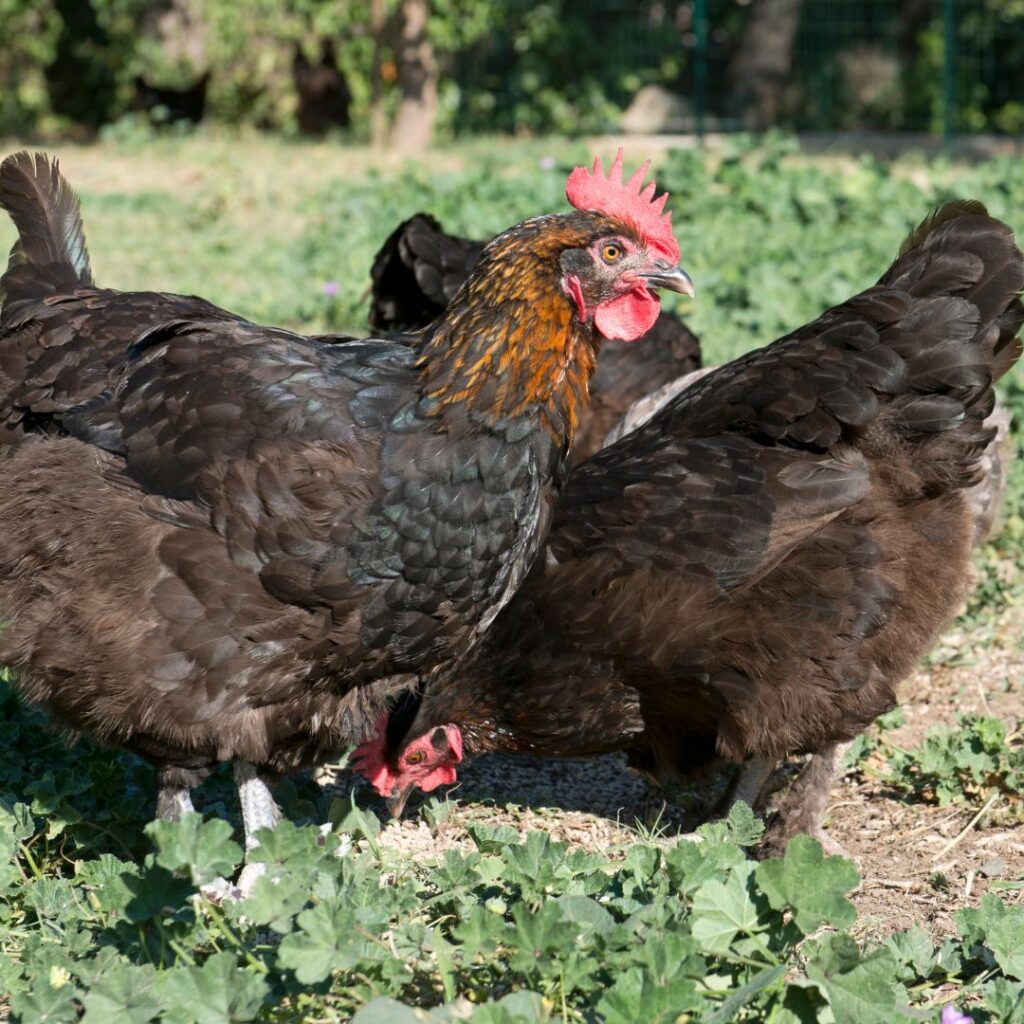
Through selective breeding, these gentle birds have been crossed with breeds such as Brahmas, Malines, and Langshan over the years to improve their characteristics.
Marans chickens are a wonderful poultry choice for both meat and eggs. Some U.S. hatcheries offer hybrid Marans breeds capable of laying up to 250 dark brown eggs a year! The large rooster of the Marans chicken makes for decent meat chicken.
Hens and roosters are known for being calm and docile. They tend to be quieter than other poultry, making them ideal pets for suburban or city homes.
- Dual Purpose: Yes
- Eggs: Large, Dark (chocolatey) Brown, 200-250+ eggs per year
- Foraging: Yes
- Heat Tolerant: Yes
- Cold Tolerant: Yes
- Meat Production: Yes
- Age til Mature: 20 weeks
- Rooster Weight:7-8 pounds
- Hen Weight: 6-7 pounds
Olive Eggers
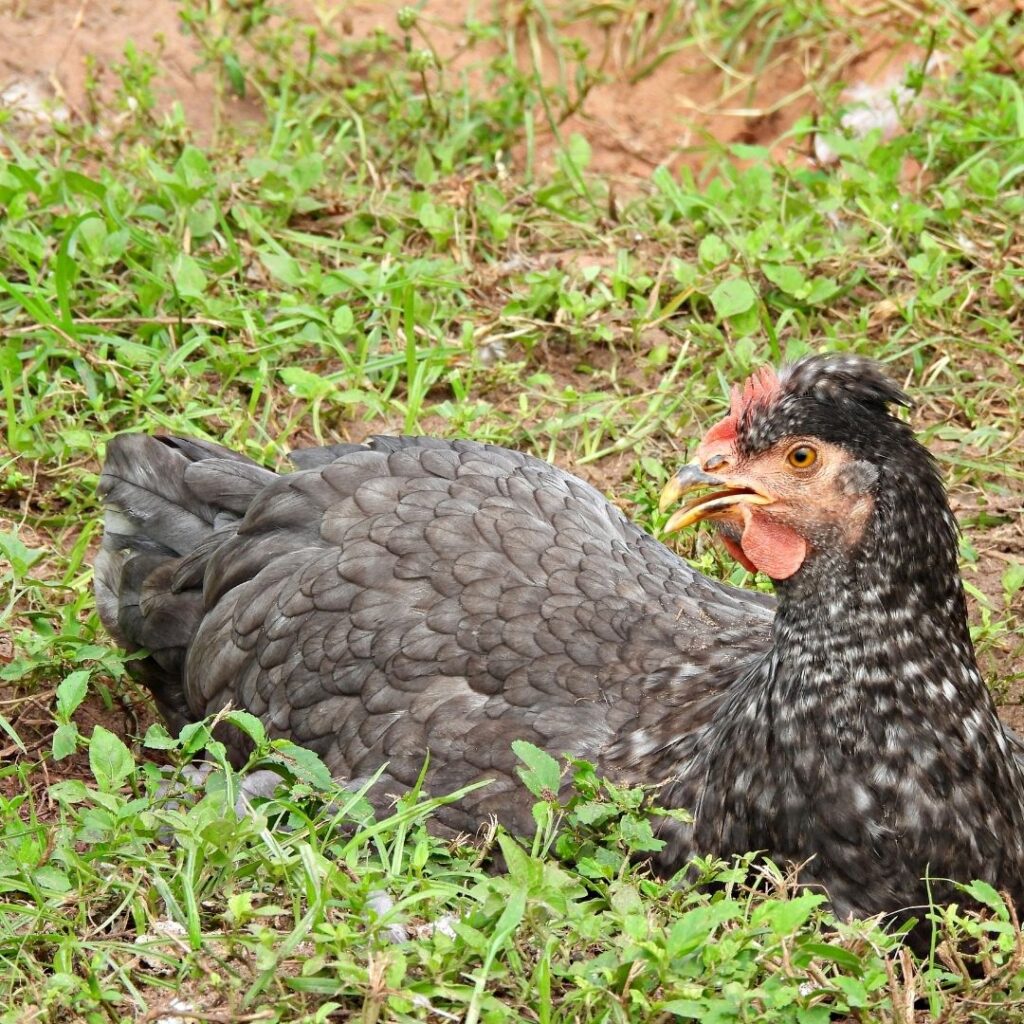
Olive Eggers are the perfect choice for anyone looking for both a hardy chicken and a unique egg color. Created by pairing blue egg layers with brown egg layers, they bring the best traits of each breed to the table while embodying their own wonderfully friendly characteristics.
They are also low-maintenance and cold-hardy, producing large eggs at a decent rate, and getting along with other chicken breeds in the coop. They’re a fairly quiet bird, yet chatty – contentedly clucking away without being too loud.
- Dual Purpose: No
- Eggs: Medium – Large, Olive Green, 150-200 eggs a year
- Foraging: Yes
- Heat Tolerant: Yes
- Cold Tolerant: Yes
- Meat Production: No
- Age til Mature: 20 weeks
- Roosters Weigh: 5 ½ pounds
- Hens Weigh: 6 ½ pounds
Rhode Island Red
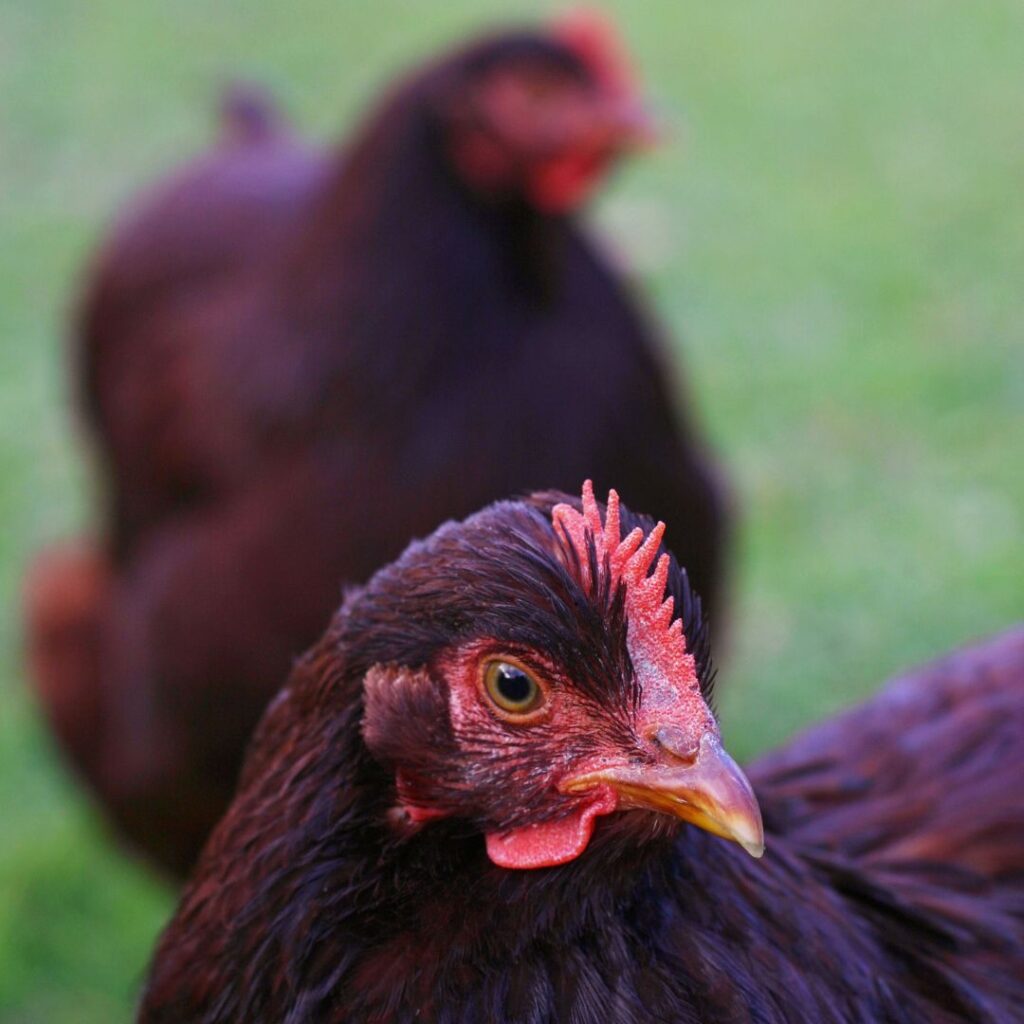
The Rhode Island Red is a well-known dual-purpose breed of chicken that is much beloved for its ability to handle cold and warm climates. This is one of the most popular chicken breeds among backyard chicken keepers in the U.S. Their status as one of the best egg laying chicken breeds in the world, help a lot too.
Hens are typically docile and enjoy interacting with people. While they can also be quite friendly with other similar breeds, it’s recommended not to mix them with more docile breeds like Orpingtons or Cochins.
When Rhode Island Red hens lay eggs, they make quite the production, clucking at regular intervals until their egg has been safely produced. You’ll want to prepare yourself for increased noise levels in the early morning hours, especially as hens tend to be most active during these times.
Rhode Island Reds are chatty chickens throughout the day and are always sure to communicate with each other at any sign of potential danger or visitors. While they are not ‘loud,’ they do chat often. They are quiet ‘ish.’ The Rooster is loud and will crow for long periods of time, especially if there is another rooster within earshot.
- Eggs: Large Brown, 200 – 280 eggs per year
- Foraging: Yes
- Heat Tolerant: Yes
- Cold Tolerant: Yes
- Meat Production: Yes
- Age til Mature: 19 weeks
- Rooster Weight: 8.5 pounds
- Hen Weight: 6.5 pounds
Sussex

The Speckled Sussex chicken is the oldest breed recorded as far back as 43 AD. It is known for being a dual-purpose bird that can be used for meat and eggs, making it an ideal choice for backyard hobby farms in cold climate zones. Unlike others, the Speckled Sussex is quite friendly, with a calm disposition. Their speckled feather patterns make it an attractive breed to many chicken enthusiasts across the globe. These chickens tend to prefer peaceful environments and could get overwhelmed if surrounded by too many aggressive birds. Plus, their chatty spirit but relatively quiet temperament makes them great conversation partners – if you bond with them, they’ll be sure to follow you around and tell you all about their day.
- Dual Purpose: Yes
- Eggs: Large Brown, 180 – 240 per year
- Foraging: Yes
- Heat Tolerant: Yes
- Cold Tolerant: Yes
- Meat Production: Yes
- Age til Mature: 20 weeks
- Rooster Weight: 9 pounds
- Hen Weight: 7 pounds
Other Breeds of Quiet Chickens
Bantam chickens can be an excellent option for urban dwellers. They take up far less space; some are also known for being quieter breeds. The only downside is the size and quantity of eggs. However, you can easily offset that by adding a couple of bantam breeds to your bantam flock.
Are All Bantam Breeds Quiet?
Not all bantam breeds are quiet chickens. Just like other chicken breeds, there are quieter choices you can make to help keep the ‘peace’ and be a good neighbor.
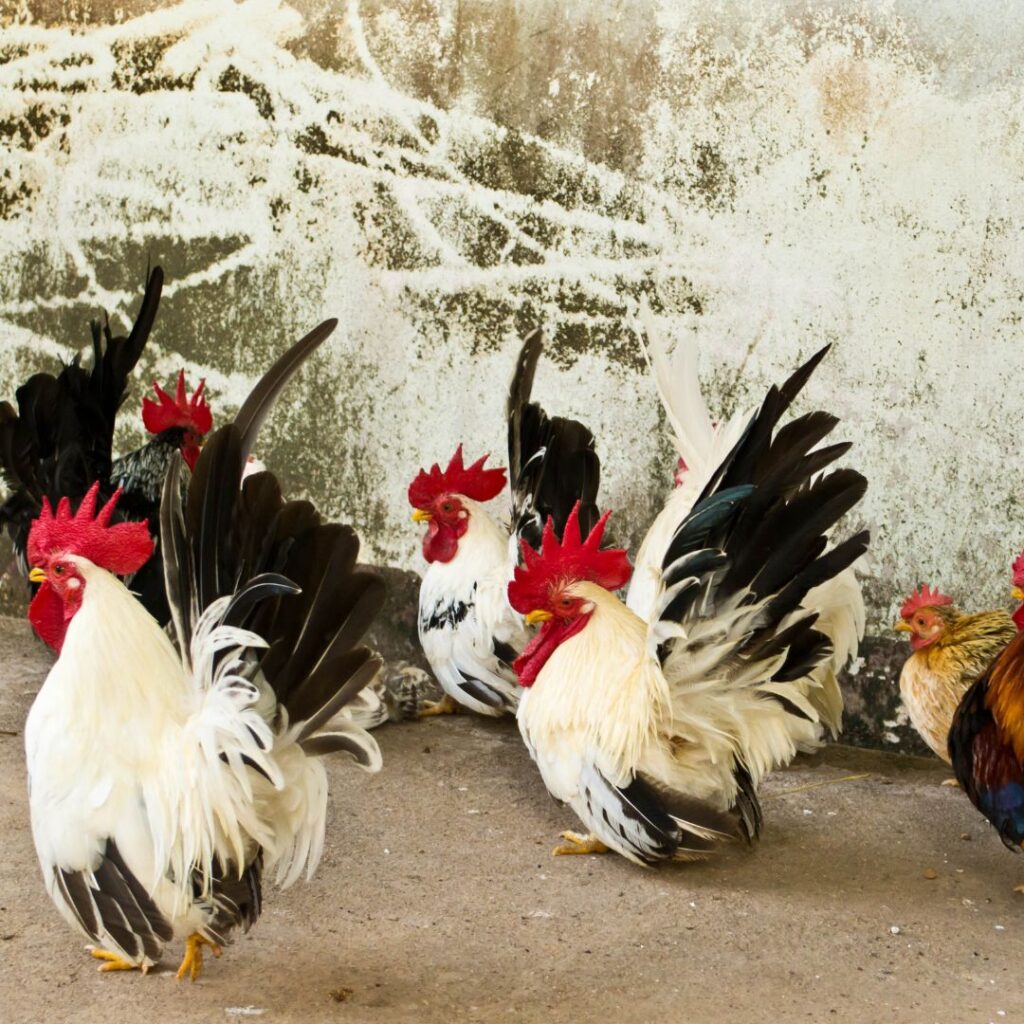
Quiet Bantam Chickens
Many standard breeds have ‘bantam’ size breeds that share similar personality traits. Among some of the quiet bantam chickens are Silkies, Brahma, and Cochin bantams. There are also breeds like the Sebright and Mille Fleur worth considering.
Why Are Quiet Chickens Good For Urban Chicken Keepers?
- Quiet Chickens Make Good Neighbors
- Sharing Farm Fresh Eggs and organic fertilizer can benefit the well-being of your neighbors.
- A place to use your kitchen scraps.
- Children in the neighborhood can get a first-hand peek at one way to have a sustainable lifestyle, learn about how egg layers hatch eggs, raising chickens, and so much more.
- Seniors in your neighborhood may have fond memories of growing up on or visiting a relative’s farm as a child. Quiet, friendly birds can be pretty comforting and are considered therapy birds and comfort animals.
- A Free-range flock in your little chicken world can eat less desirable bugs like grubs and ticks from your yard.
- Healthy, nutritious eggs right out your back door.
- Relaxing, rewarding, and sometimes comical watching them and being able to have little conversations with your new feathered pets.
Learn About 15+ Heat Tolerant Chicken Breeds Here.
How do Chicken Owners keep chickens Happy, Healthy, and Laying Eggs?
Chicken Coop – Always follow recommended coop size for your flock. Indoor space is essential to the overall well-being of your bird. The average indoor space is 4-6′ per bird, depending on their breed size.
Perches – Perches are where your hens will get some shut-eye and dream sweet egg dreams. The perch is also where they can huddle together to keep warm on cold days and nights. Be sure perches are at recommended maximum height.
Large birds can injure themselves by jumping too far. It is recommended these be 12″ in length per chicken.
Nesting Boxes – You’ll need one nesting box for each hen that lays eggs. 8 hens = 2 nesting boxes, 16 hens = 4 nesting boxes, etc. Nesting boxes should be sized appropriately to the largest hen’s size.
The largest nesting boxes are typically 12″ square with a deep setting area with extra bedding to cushion those farm-fresh eggs. The Jersey Giant will require a larger nesting box of 18″ square with a deeper bottom; these are big girls.
Keep your egg layers comfy, and they’ll reward you well. See tips on how to clean and store eggs here.
Water and Feed – chicken feed and water should be fresh and clean at all times.
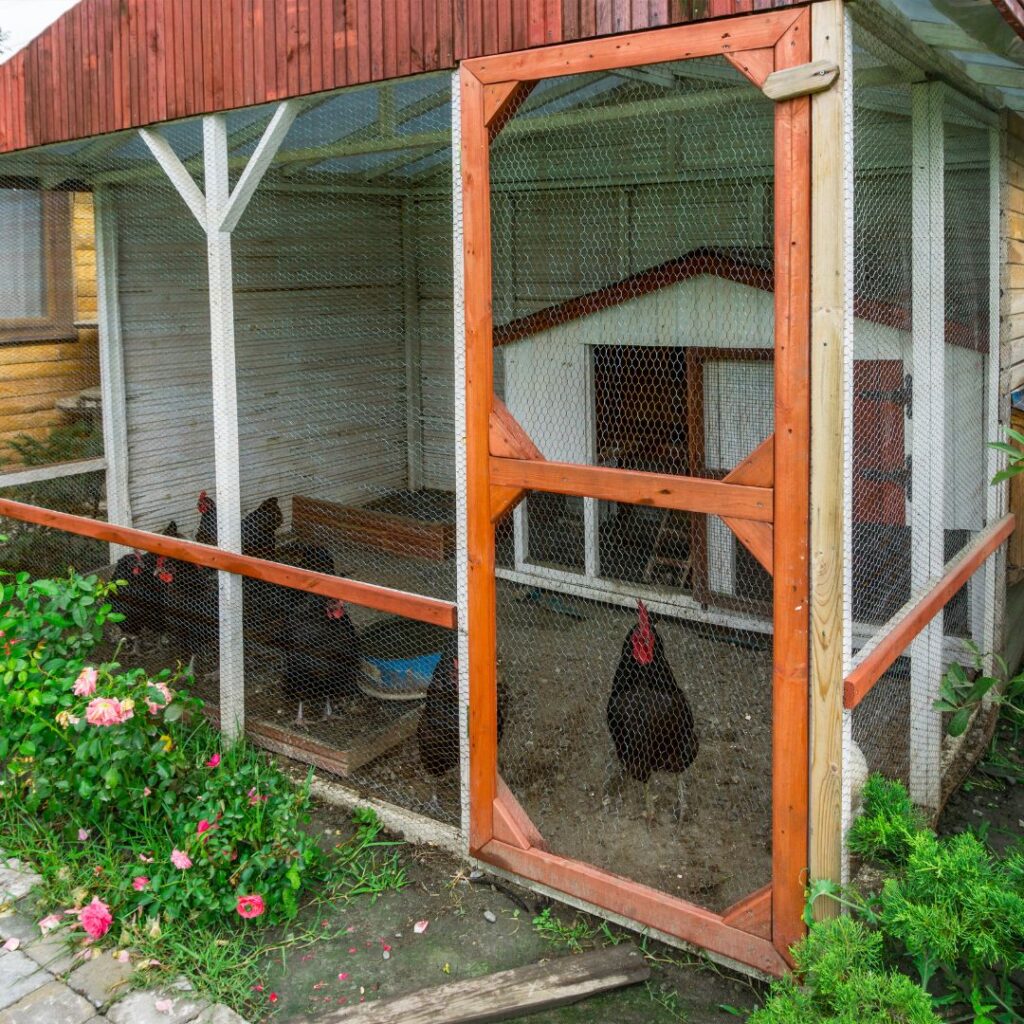
Chicken Run
Size – Bigger “is” better when keeping chickens quiet—minimum 10 square feet per bird for confined birds. If your flock can roam and forage regularly, you can afford to size down to about 6 square feet per chicken.
Shelter From The Elements – Your chicken run should have protection from the elements. A roof is ideal, but you can create a cover with a lean-to, a tarp, or shade cloth.
Chickens need a dry place to be outside, free of rain, snow, and sleet. During the summer, a shady space to help them keep cool.
Perches – A perch will give chickens quiet and alone time to decompress. Nail a shelf-type structure to the side of the coop, place an old wooden step ladder in the run area, and even logs and upturned buckets can all be used as perch space. These are especially helpful with active birds.
Fencing – Fencing height needs to be a minimum of 6′ to safely keep your chickens contained and, more importantly, to keep predators out. Overhead fending is an excellent idea to help with overhead predators like hawks; this can be a hardware cloth or a chicken wire secured across the top of the run area.
Dust Bath – Create an area for dust-bathing chickens with an old tire, an old kiddie pool or re-cycled sandbox, or even a dug-out space in the run. Add some contractor sand, diatomaceous earth, and clean wood ash. This mixture eliminates lice and mites from your chicken and makes them look all fancy with its clean, shiny, and fluffy feathers. If you have chickens, you need to have a dust bath!
Read more about preparing for winter with chickens here.
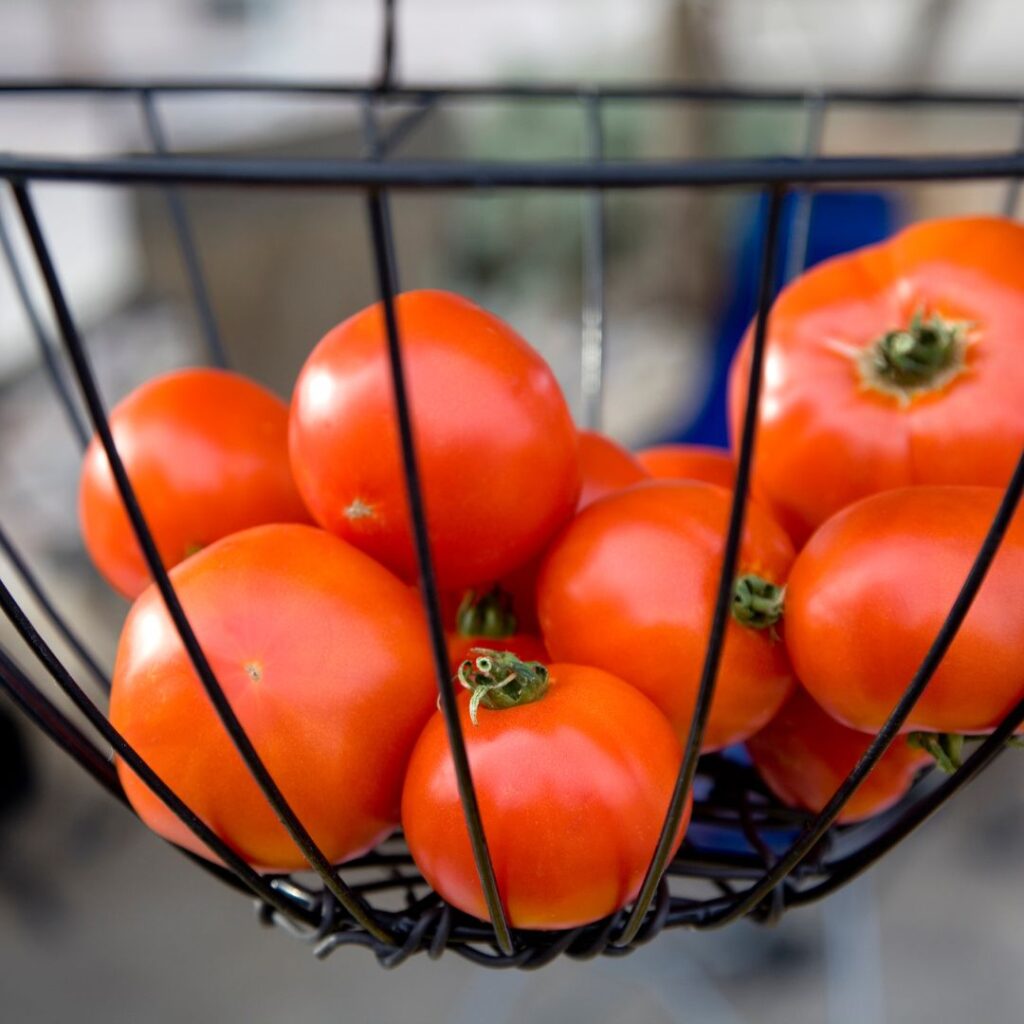
Healthy Ways To Keep Your Chickens From Getting Bored And Making A Ruccous
Even with quiet birds, there can be occasions for them to get fussy if you find your flock being restless or, worse, picking on one another. You should add some ways to help them find new forms of exercise and entertainment.
- Outdoor Roosts, Ladders, or Perches
- Stumps or other objects to hop up on, like upturned buckets and even old plastic toddler slides
- A Swing made from a piece of wood and rope or chain.
- Secure a Mirror on Coop Wall
- Bales of Straw, Hay, Piles of Leaves, or grass clippings
- Free Range in a fenced area while you spend time with them
- Flock Blocks, Scratch, hanging Food Treats like heads of lettuce or cabbage (hang from rope or chain), mealworms. Cold weather treats like mashed veggies or pot of oatmeal, warm weather treats like giant ice cubes filled with fruit, veggies, and scratch or sunflower. Toss some mealworms or a few dried grubs for a healthy snack.
- Anything exciting and new, like a Christmas tree or even fallen branches of varying sizes or weeds from the garden.
- Dust Bath area
- Expand your Run Area
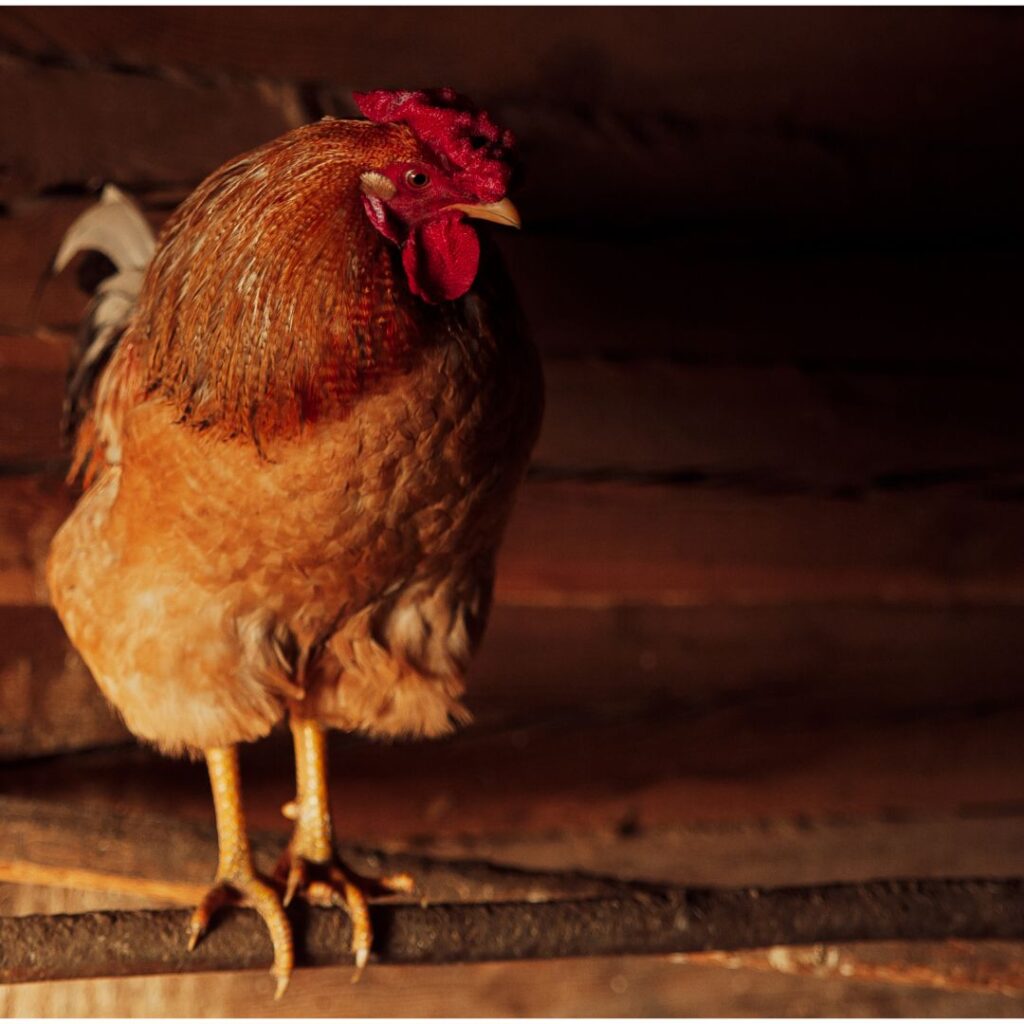
What Is The Noisiest Chicken Breed?
The Polish Chicken takes the #1 place on the noisy chickens’ list.
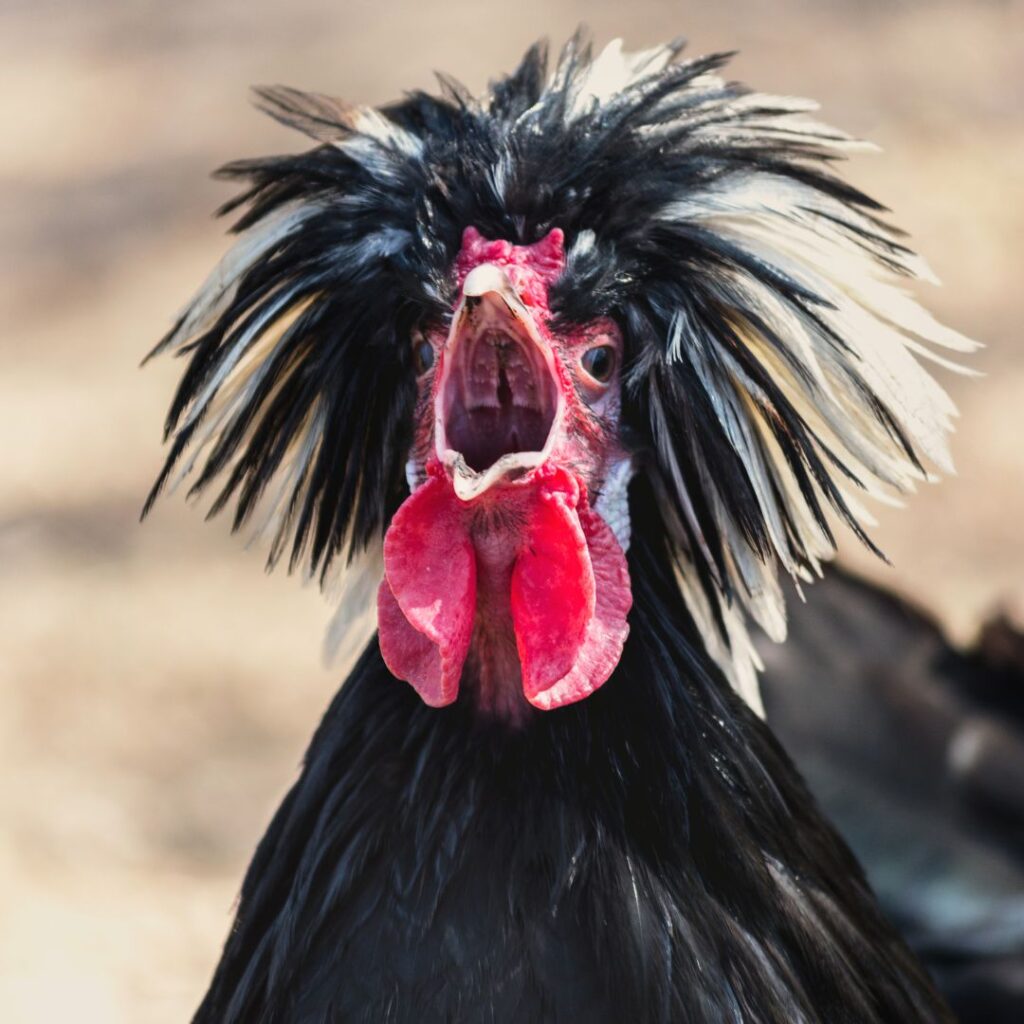
Polish Chickens: Pom Pom, Top Hat Chickens; All About
Choosing Quiet Chicken Breeds for Urban And Suburban Living
Choosing the right breed of chicken is vital if you plan on keeping them in an urban area without disrupting your neighbors’ peace and quiet. This is especially true if you live in a metropolitan area where peace is already hard enough to come by.
Luckily, several types of quieter chicken breeds are available that are excellent choices for those looking for peaceful suburban and city dwellers.
You can find the perfect match for your backyard flock with some research into different breeds and their temperaments.
With these tips in mind (and some tips for beginner chicken owners)– now all that’s left is deciding which breed best suits your family’s needs -you’ll have your own eggs right out your door before you know it.
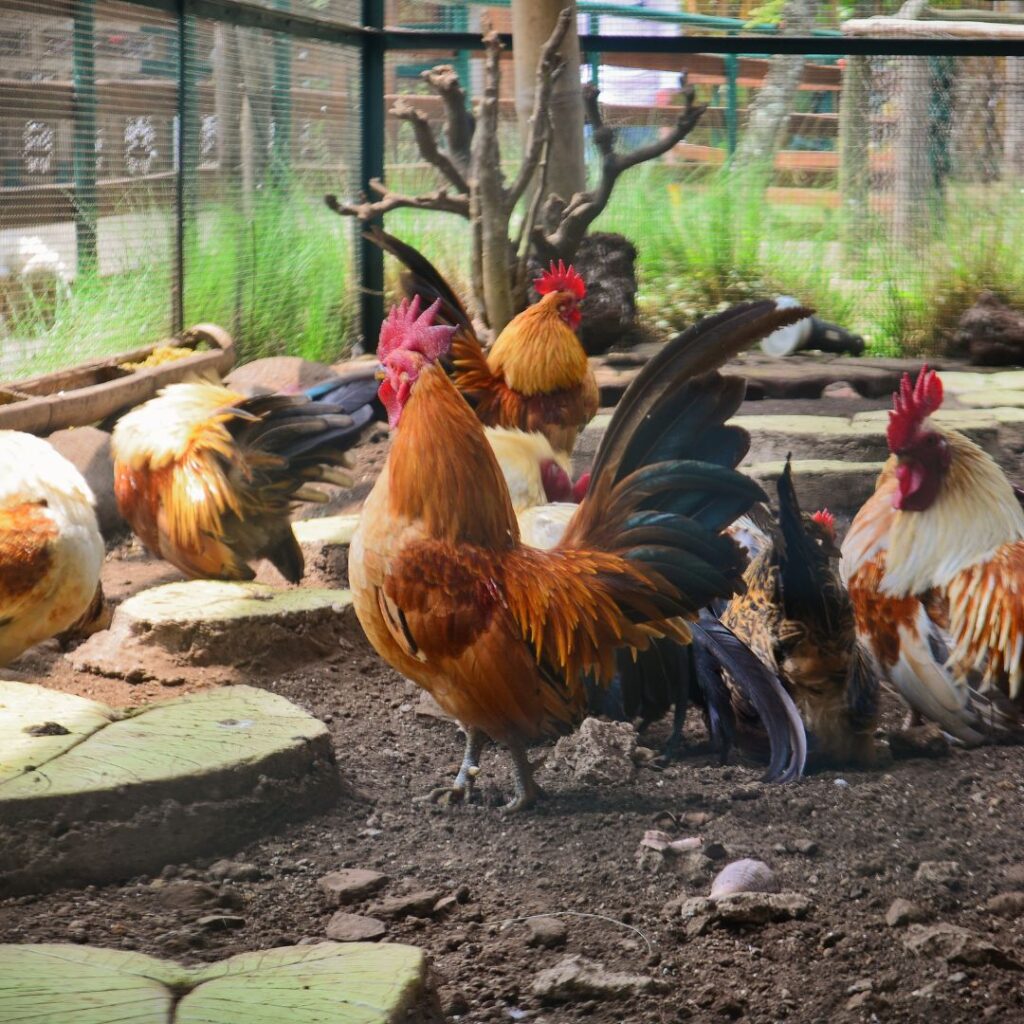

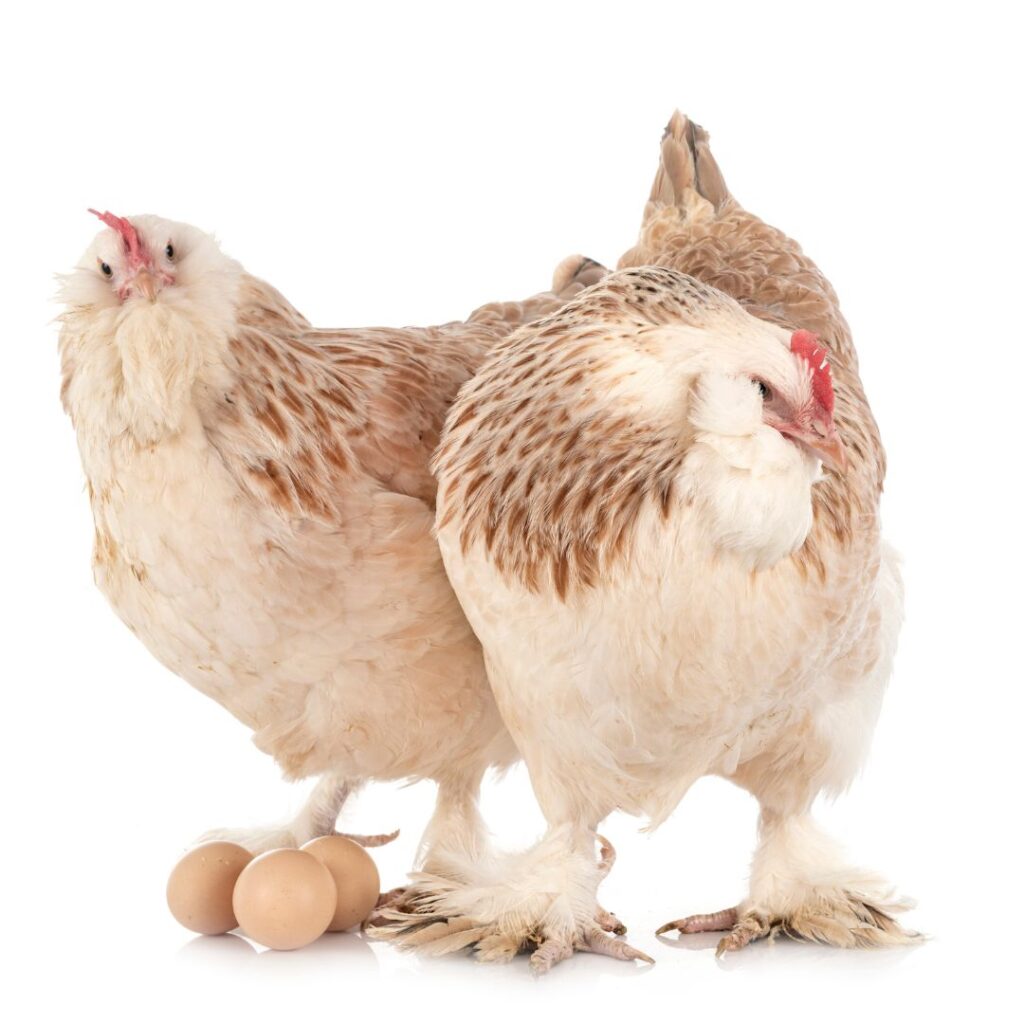
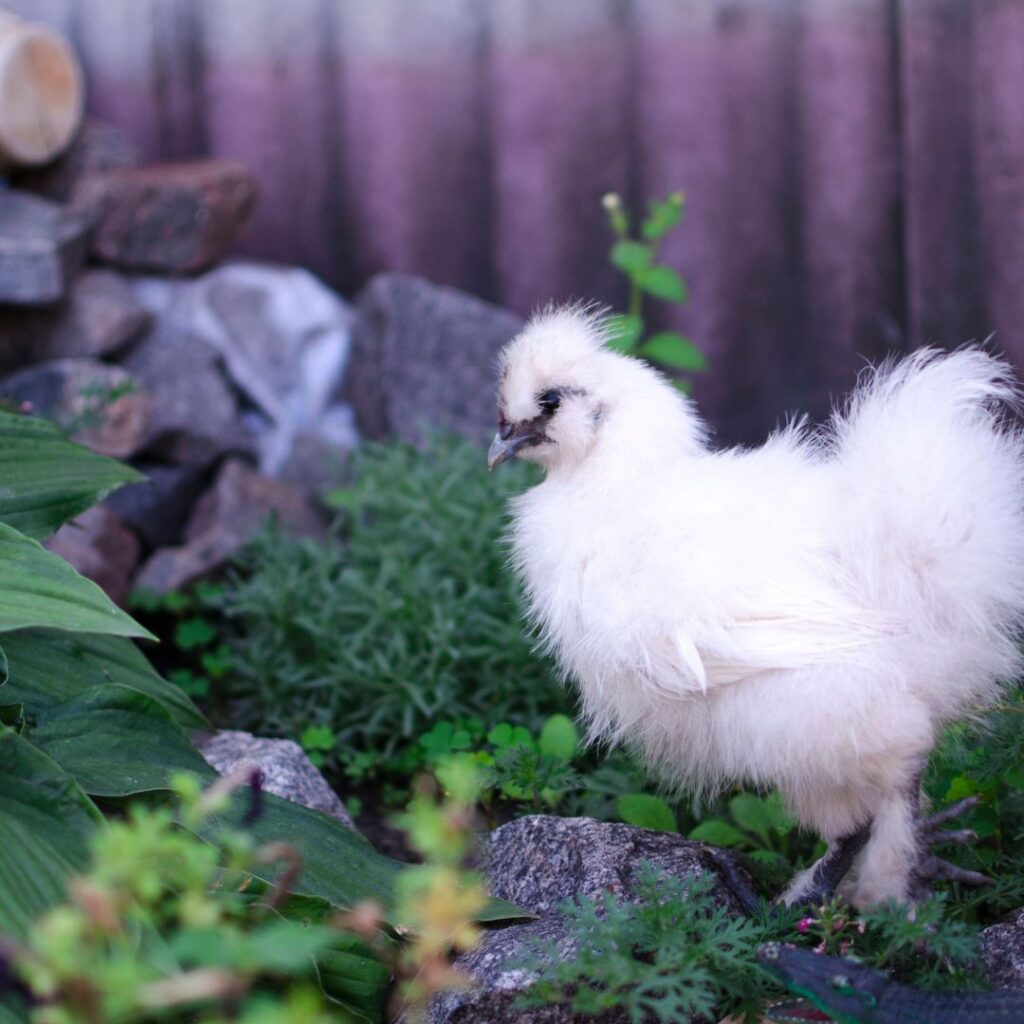
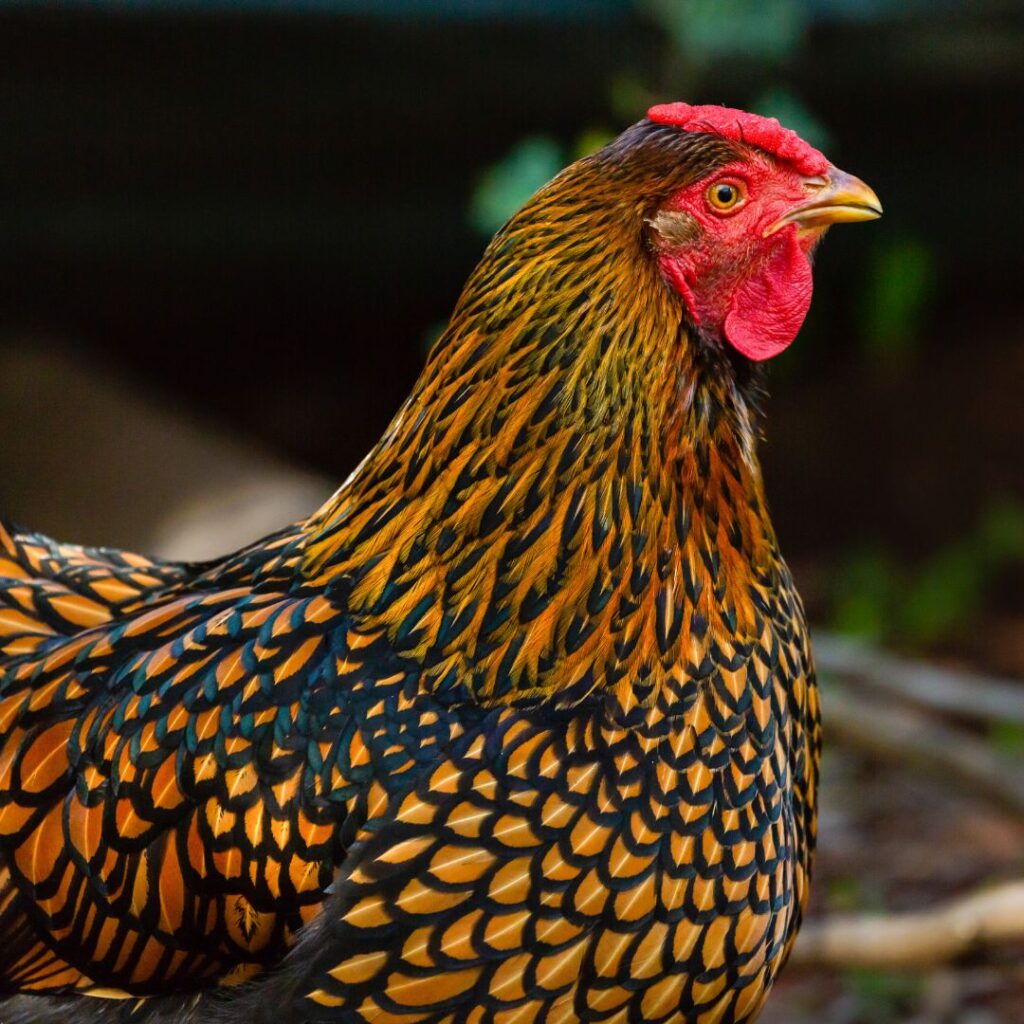
Pingback: Welsummer Chicken; Beautiful Dark Brown Eggs And More-About The Breed
Pingback: Cornish Chickens: A sweet Heritage Breed - Gilmore's
Pingback: When Is The Best Time To Get Chickens As Baby Chicks?
Pingback: Buckeye Chicken Breed; Only American Breed Developed By A Woman